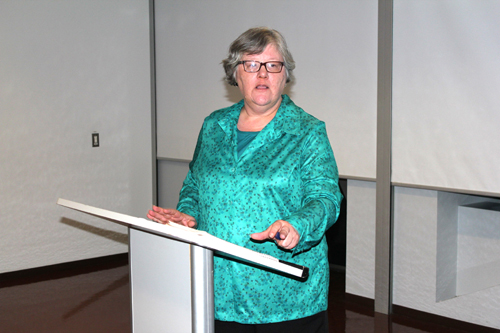By James Tabafunda
Northwest Asian Weekly

Marian Smith (Photo by James Tabafunda/NWAW)
The family trees of Asians in the United States will create a much larger forest as they become the largest immigrant group in 2055, according to a Pew Research Center study released last month.
The proper conditions for the growth of these trees can be attributed to the first federal naturalization law enacted in 1790 allowing foreign-born people to become U.S. citizens, and the number of active family-history researchers remains high as genealogy continues to be one of America’s top hobbies – along with gardening.
Researching the origins or roots of just one Asian American family tree becomes much easier with information from U.S. Citizenship and Immigration Services (USCIS). Marian L. Smith, a USCIS historical records expert in its records division, talked about various genealogical records and related issues at the downtown Seattle Public Library (SPL) on Oct. 20.
Before SPL genealogy librarian John LaMont introduced her, he said, “We have one of the largest genealogy collections in the Pacific Northwest, roughly 45,000 print volumes as well as several different online databases. You can make appointments for one-on-one time, 30 minutes.”
Smith began her presentation, “Immigration and Nationality Records Review,” saying she would talk about a lot of things, “but really I’m just talking about one thing, and that is an approach to this kind of research.”
She discussed three key eras: Early (18th and 19th centuries), Great Wave (early 20th century), and Recent (late 20th century). She provided several detailed examinations of both Asian and non-Asian immigrants.
“Each one has, basically, its own records, its own problems, its own procedures and locations (National Archives, USCIS, or other) where you go to find the records,” she said.
Examples of these records include Alien Files (A-Files), the official file for all immigration records created since April 1, 1944, and Court Naturalization Records from 1790 to 1992.
“There’s so many variables in this. The records are constant. The laws are constant, but these people are never constant. Everybody’s different.… You seldom find the same records for every single person,” Smith said.
Along with knowing the right approach to this kind of research, another important action is talking to your closest family members and friends about important dates related to your family.
Smith said, “It’s not about when they were born. It’s not about when they got off the ship. It’s about what happens to them later in life.”
These dates can then be plotted on a timeline of the three eras, which identifies the records that apply and can be requested.
“That’s why I use a timeline, of course, when researching immigration and nationality records, not just the date of arrival or the date of naturalization, but how long people lived, and if they lived through events or have reason to create additional records,” she said. “Think about their whole life.”
The USCIS Genealogy Program offers a Genealogy Index search that gives access to the immigration and naturalization records of deceased immigrants, one that requires filling out
Form G-1041 and paying a $20 fee. The program has separate requests: the index search, then the file request.
Smith said, “We really do recommend people start with the search, and find out if there’s any record and, if so, what kind of record? Where is it today?”
“The real beauty of these records is the documents attached,” she added.
“I know naturalization records are not easy to find, and they’re not all on the Internet.”
USCIS holds webinars on the Internet on how to get into immigration and nationality records.
More advanced genealogical research may require travel to local government offices in Asia.
Retired Brigham Young University (BYU) family history professor Basil Yang mentioned these offices in a BYU television interview in 2006.
Household registrations, called “hukou” in Chinese, are a system that classifies each person as an urban or rural resident and determines their eligibility for state-provided services and welfare. Yang said, “From the household registration, you can trace at least three or four generations from that record.”
Japan, Vietnam, and Taiwan also use the household registration system.
“Kamon” in Japanese are family crests – similar to European coats of arms – that are used to identify a family.
Yang said about researching Japanese families: “It’s very hard to trace their genealogy because of the fact that sometimes they change their family names.”
There are many variables in genealogy, indeed. (end)
For more information about U.S. Citizenship and Immigration Services, visit www.uscis.gov/historyandgenealogy. For more information about researching Asian genealogy at the National Archives, visit http://www.archives.gov/research/alic/reference/ethnic-heritage.html#asian. For more information about the Genealogy Collection at the Seattle Public Library, visit http://www.spl.org/locations/central-library/cen-plan-a-visit/cen-special-collections.
James Tabafunda can be reached at info@nwasianweekly.com.



